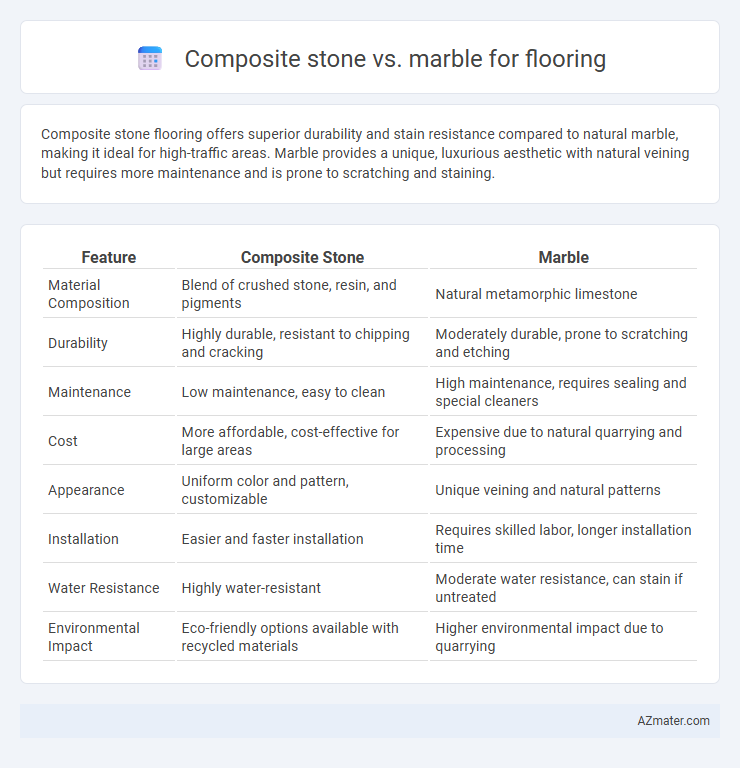Composite stone flooring offers superior durability and stain resistance compared to natural marble, making it ideal for high-traffic areas. Marble provides a unique, luxurious aesthetic with natural veining but requires more maintenance and is prone to scratching and staining.
Table of Comparison
| Feature | Composite Stone | Marble |
|---|---|---|
| Material Composition | Blend of crushed stone, resin, and pigments | Natural metamorphic limestone |
| Durability | Highly durable, resistant to chipping and cracking | Moderately durable, prone to scratching and etching |
| Maintenance | Low maintenance, easy to clean | High maintenance, requires sealing and special cleaners |
| Cost | More affordable, cost-effective for large areas | Expensive due to natural quarrying and processing |
| Appearance | Uniform color and pattern, customizable | Unique veining and natural patterns |
| Installation | Easier and faster installation | Requires skilled labor, longer installation time |
| Water Resistance | Highly water-resistant | Moderate water resistance, can stain if untreated |
| Environmental Impact | Eco-friendly options available with recycled materials | Higher environmental impact due to quarrying |
Introduction to Composite Stone and Marble Flooring
Composite stone flooring combines crushed natural stone and resin to create a durable, low-maintenance surface that resists stains and scratches better than traditional flooring materials. Marble flooring, a timeless natural stone option, offers unique veining patterns and luxurious aesthetics but requires regular sealing and careful maintenance to prevent damage. Choosing between composite stone and marble depends on balancing durability, maintenance needs, and desired visual appeal for interior spaces.
Composition and Manufacturing Differences
Composite stone flooring consists of natural stone fragments mixed with resin and pigments, creating a durable and uniform surface; it is manufactured through a curing and compression process that enhances strength and reduces porosity. Marble flooring is a natural metamorphic rock primarily composed of recrystallized carbonate minerals, obtained through quarrying and then cut and polished to reveal its unique veining and texture. The manufacturing of composite stone allows for consistent coloration and pattern control, while marble's natural formation results in unique but less uniform slabs.
Aesthetic Appeal and Design Options
Composite stone flooring offers a wide range of customizable colors, patterns, and textures that mimic natural stone while providing enhanced durability and resistance to staining compared to marble. Marble is prized for its unique veining and timeless elegance, making each slab distinct and highly desirable in luxury aesthetics. While marble's natural variations create a classic look, composite stone allows for more consistent design themes and greater flexibility in modern architectural styles.
Durability and Strength Comparison
Composite stone flooring typically offers greater durability and resistance to scratches, stains, and impact compared to marble, making it ideal for high-traffic areas. Marble, while naturally elegant, is softer and more porous, requiring regular sealing to maintain its strength and prevent chipping or etching. The engineered composition of composite stone ensures consistent hardness and long-term structural integrity, outperforming marble's susceptibility to wear over time.
Maintenance and Cleaning Requirements
Composite stone flooring requires minimal maintenance, needing only regular sweeping and occasional damp mopping with mild detergent to keep its surface stain-resistant and durable. Marble flooring demands more rigorous care, including frequent sealing to protect against scratches and moisture, and specialized cleaners to preserve its natural veining and shine. Composite stone's non-porous nature reduces the risk of staining compared to marble, which is more susceptible to etching and discoloration from acidic substances.
Cost Analysis and Budget Considerations
Composite stone flooring offers a more cost-effective solution compared to marble, with prices typically ranging from $5 to $10 per square foot, whereas marble floors can cost between $10 to $30 per square foot. Installation costs for composite stone tend to be lower due to its easier handling and durability, reducing long-term maintenance expenses. Budget-conscious projects benefit from composite stone's blend of affordability and aesthetic appeal, while marble's higher upfront and upkeep costs suit premium or luxury budgets.
Installation Process and Timeframe
Composite stone flooring features a straightforward installation process involving interlocking tiles or adhesive application, significantly reducing labor time compared to marble. Marble requires precise cutting, sealing, and typically professional installation to prevent cracking and ensure durability, leading to longer project timelines. The overall installation timeframe for composite stone is commonly shorter, with many projects completed within days, while marble flooring often demands weeks for proper fitting and curing.
Resistance to Stains, Scratches, and Moisture
Composite stone flooring offers superior resistance to stains, scratches, and moisture compared to marble, making it ideal for high-traffic areas and moisture-prone environments. Its non-porous surface prevents water absorption and resists staining from spills, while its engineered composition enhances durability against scratches and wear. Marble, although elegant, is more porous and susceptible to etching and damage from acidic substances, requiring regular sealing and maintenance to preserve its appearance.
Environmental Impact and Sustainability
Composite stone flooring offers a more sustainable option compared to marble due to its use of recycled materials and lower energy consumption during production. Marble extraction leads to significant environmental degradation including habitat destruction and high carbon emissions from quarrying processes. Choosing composite stone can reduce ecological footprints while maintaining durability and aesthetic appeal in flooring applications.
Choosing the Right Flooring for Your Space
Composite stone offers enhanced durability and resistance to stains and scratches compared to marble, making it ideal for high-traffic areas and households with pets or children. Marble provides a timeless, elegant appearance with unique veining patterns but requires more maintenance due to its porous nature and susceptibility to etching and staining. Selecting the right flooring depends on balancing aesthetics, durability, maintenance needs, and budget, with composite stone excelling in practicality and marble favored for luxury and classic beauty.

Infographic: Composite stone vs Marble for Flooring
 azmater.com
azmater.com